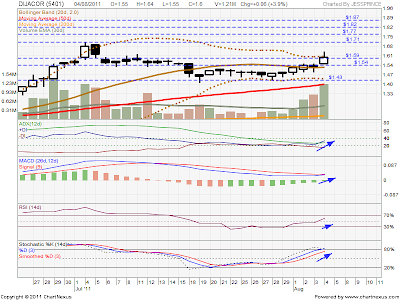Home Depot Inc., Caterpillar Inc. and Alcoa Inc. (AA) led gains among the biggest companies most-tied to the economy, rising at least 1.2 percent. Technology shares rose the most among groups in the S&P 500, with Cisco Systems Inc. and Intel Corp. advancing more than 1.9 percent. Tiffany & Co. (TIF), the world’s second-largest luxury jewelry retailer, added 7.1 percent after reporting profit that beat analysts’ estimates and raising its earnings forecast.
The Standard & Poor’s 500 Index rallied 1.2 percent to 1,173.35 at 12:02 p.m. in New York after initially plunging 2 percent following Bernanke’s remarks. The Dow Jones Industrial Average climbed 1.2 percent, or 133.09 points, to 11,282.91.
“This is exactly what the market wanted,” Keith Springer, who oversees $120 million as the president of Springer Financial Advisors in Sacramento, California, said in a telephone interview. “This is good news for investors because it’s telling you there’s no reason to panic because they have the impression is that the economy is getting better. If he threw more money at the economy it would have given the impression that things were out of control and the Fed was panicking.”
Stocks gyrated following the Bernanke speech, in which he said the central bank still has tools to stimulate the economy without signaling he will use them. He echoed comments of dissenting members of the Federal Open Market Committee who said U.S. economic data aren’t pointing to a recession.
Low Valuations
This year’s decline in the S&P 500 left the benchmark gauge for U.S. equities at 12.7 times reported earnings yesterday, more than 20 percent below its five-decade average. Barton Biggs, founder of hedge fund Traxis Partners LP, said last week that valuations are so low they could withstand a 15 percent decline in profits.Earnings for companies in the index may rise 18 percent this year, according to the average estimate of analysts surveyed by Bloomberg. Economists predict gross domestic product will expand 1.75 percent this year and 2.35 percent in 2012, according to a survey of 56 respondents conducted by Bloomberg.
“Although important problems certainly exist, the growth fundamentals of the United States do not appear to have been permanently altered by the shocks of the past four years,” Bernanke said in prepared comments. “It may take some time, but we can reasonably expect to see a return to growth rates and employment levels consistent with those underlying fundamentals.”
Restricting Options
Rising consumer prices and signs the economy is still growing may be restricting Bernanke’s options. Gasoline costs are 33 percent higher, consumer inflation is twice as fast and inflation expectations are above levels since Bernanke signaled more easing a year ago. While the U.S. expansion has slowed, the Chicago Fed’s index of 85 economic indicators improved in July for a third month on gains in production.The threat of deflation has subsided, with the Labor Department’s consumer price index, minus food and energy, rising 1.8 percent for the 12 months ending July. It increased at a 0.9 percent 12-month rate in July 2010 before Bernanke’s Jackson Hole speech last year.
A measure of inflation expectations watched by the Fed is showing that traders see annual price increases of 2.77 percent starting in five years, compared with 2.22 percent a year ago.
‘Risking Its Credibility’
Fed bank presidents Charles Plosser of Philadelphia, Richard Fisher of Dallas and Narayana Kocherlakota of Minneapolis voted against the Fed’s decision to keep the target for the federal funds rate at zero to 0.25 percent until at least mid-2013. Plosser and Fisher said last week the pledge won’t help spur growth. The last time three policy makers dissented was in November 1992.“Our problems are not problems easily addressed by monetary policy,” Plosser said in an Aug. 17 interview, adding that the Fed is “risking its credibility because it’s doing things that don’t work.”
Last year, Bernanke hinted that the Fed might embark on a second round of asset purchases to bolster the recovery, kicking off a 30 percent rally in the S&P 500 that ended in a three-year high on April 29.
Policy makers this month pledged to keep their benchmark interest rate near zero until at least mid-2013 and said they “discussed the range of policy tools” available, signaling they may add to their record stimulus.
Stimulus Options
Bernanke told Congress on July 13 the Fed has stimulus options. They may include buying additional securities, increasing the average maturity of its bond portfolio, lowering the interest rate on excess reserves and pledging to keep its balance sheet near a record high for a longer period of time.Morgan Stanley analysts have cut their estimate for expansion worldwide this year to 3.9 percent from a previous prediction of 4.2 percent. Part of the reason was “the drama” around lifting the U.S. debt ceiling, which helped depress financial markets and erode business and consumer confidence, the analysts said in a report last week.
President Barack Obama signed a plan to raise the federal debt limit on Aug. 2, the deadline to avoid a possible default, after months of wrangling with Congress. The deal would make $2.4 trillion in deficit cuts over 10 years.










































